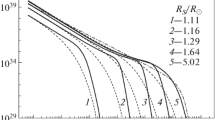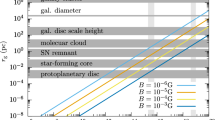Abstract
We consider a stationary model of the propagation of galactic cosmic rays (GCR) in the heliosphere and adjacent interstellar space. The heliosphere is assumed to be a two-layer medium consisting of two adjacent regions that are spherically symmetric relative to the sun. The solar wind velocity is supersonic in the inner heliosphere bounded by the standing termination shock, and this velocity is subsonic in the outer heliosphere bounded by the heliosheath. The GCR scattering in these regions is due to different factors characterized by relevant diffusion coefficients. The solar wind velocity is assumed to be zero in the interstellar medium, where the scattering becomes weaker. No particle sources are presumed to exist at the boundaries between the layers. An exact analytical solution of the corresponding mathematical problem can be obtained without essential difficulties, although it is extremely cumbersome. Analytical expressions for the GCR spectra of particles with very high energies (>2500 MeV) and very low energies (<1400 MeV) are obtained for each region of particle propagation. The low-energy particle distribution corresponds to the data obtained by the Voyager spacecraft. It is shown that the low-energy particle density continuously increases from the sun toward the heliospheric boundary, regardless of the scattering mode in the inner and outer parts of the heliosphere.
Similar content being viewed by others
References
V. A. Ditkin and A. P. Prudnikov, Integral’nye preobrazovaniya i operatsionnoe ischislenie (Integral Transforms and Operational Calculus), (Nauka, Moscow, 1974) [in Russian].
A. Z. Dolginov and I. N. Toptygin, “Multiple Scattering of Particles in Magnetic Field with Random Inomogeneities,” Zh. Eksp. Teor. Fiz. 51, 1771–1783 (1966).
A. Z. Dolginov and I. N. Toptygin, Theory of Motion of Cosmic Particles in Interplanetary Magnetic Fields, in Proc. 5th All-Union Workshop on Cosmophysics (Izd. Kol’skogo filiala Akad. Nauk, Apatity, 1968), pp. 167–182.
Yu. L. Kolesnik and B. A. Shakhov, “Galactic Cosmic Ray Distribution in the Simplest Model of Termination Shock near the Heliospheric Boundaries,” Kinem. Fiz. Celest. Bodies 25(4), 213 (2009).
B. A. Shakhov and Yu. L. Kolesnik, “Heliospheric Propagation of Galactic Cosmic Rays Depending on the Scattering Characteristics of the Turbulent Interplanetary Magnetic Field,” Kinem. Fiz. Celest. Bodies 24(6), 426–440 (2008).
V. Florinski and N. V. Pogorelov, “Four-Dimensional Transport of Galactic Cosmic Rays in the Outer Heliosphere and Heliosheath,” Astrophys. J. 701, 642–651 (2009).
M. L. Goldstein, R. Ramaty, and L. A. Fisk, “Interstellar Cosmic Ray Spectra from the Non-Thermal Radio Background from 0.4 to 400 MHz,” Phys. Rev. Lett. 24(21), 1193–1196 (1970).
P. Kiraly, “Recent Voyager Data and Unexpected Properties of the Heliosphere Termination Shock,” in Proc. 21st European Cosmic Ray Symp. (Kosice, 2008), pp. 159–163.
F. B. McDonald, “Voyager Observations of Galactic and Anomalous Cosmic Rays at the Termination Shock and in the Heliosheath,” in Proc. 30th Int. Cosmic Ray Conf. (Merida, 2007) 6, 167–180 (2009).
E. N. Parker, “The Passage of Energetic Charged Particles through Interplanetary Space,” Planet. Space Sci. 13, 9 (1965).
J. S. Perko, “Solar Modulation of Galactic Antiprotons,” Astron. Astrophys. 184(1), 119–121 (1987).
V. S. Ptuskin, H. J. Volk, V. N. Zirakoshvili, and D. Breitschwerdt, “Transport of Relativistic Nucleons in a Galactic Wind Driven by Cosmic Rays,” Astron. Astrophys. 321(2), 434–443 (1997).
I. H. Urch and L. J. Gleeson, “Galactic Cosmic Ray Modulation from 1965–1970,” Astrophys. Space Sci., No. 17, 426–446 (1972).
Author information
Authors and Affiliations
Additional information
Original Russian Text © Yu.L. Kolesnik, B.A. Shakhov, 2012, published in Kinematika i Fizika Nebesnykh Tel, 2012, Vol. 28, No. 6, pp. 3–16.
About this article
Cite this article
Kolesnik, Y.L., Shakhov, B.A. Effect of the heliosheath and standing termination shock on galactic cosmic ray propagation in a stationary heliosphere model. Kinemat. Phys. Celest. Bodies 28, 261–269 (2012). https://doi.org/10.3103/S0884591312060049
Received:
Published:
Issue Date:
DOI: https://doi.org/10.3103/S0884591312060049




